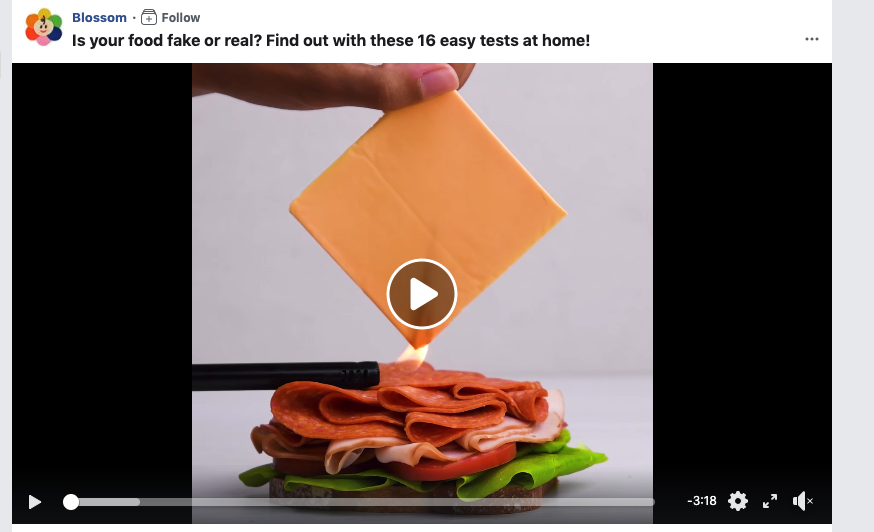LONDON – Food videos have become a staple of social media. Impossibly arranged sandwiches with finely balanced garnish and slow motion shots of sauces drooling like Homer Simpson are only ever a click and a swipe away, and often hugely profitable.
A video published on Saturday June 1 had all these hallmarks for social media success, then added another layer of virality.
“Rice is mixed with plastic bits to increase manufacturer profit!” read the subtitles as the camera zooms in on a frying pan holding tiny grains turning translucent with the heat.
“Ice cream that bubbles contains washing powder for shine and lightness,” reads another caption as well-manicured fingers squeeze lemon juice over the offending dessert.
Another of these 16 “tests” for “fake” food shows a hand tip what the video purports to be baby food into a zip-lock bag. The bag is flattened and evened before a series of fast cuts show a magnet pulled across the paste, dragging tiny black dots in its wake.
“These are ground-up rocks advertised as fortified calcium!” screams the text.
By Sunday afternoon, the video had been viewed more than 40 million times on Facebook. By Thursday it was 87 million. More than 500,000 reactions, 216,000 comments and over 3,000,000 shares. By almost any metric it’s a viral media smash hit.
“A lot of the claims that are being made [would be] highly illegal in the United States and they would come with penalties,” said Pete Cassell, a spokesman at the US Food and Drug Administration (FDA).
“Our food is inspected and monitored and if these kind of things were happening we would know about it and we would take action against a company that was doing something like this.”
“We want to make sure that when a consumer sees advice it has backing and is based on science and are the best recommendations that experts are giving. Not just some rumour from the internet” – Pete Cassell, FDA
The full, three-and-a-half minute video was published by First Media, a Los Angeles-based production house, and published to the verified Facebook page of Blossom, its brand aimed at young women and mothers.
This is not some shady fake news fringe site, but an established company with its own TV channel and viral marketing arm for major brands like Tinder and Pepsi. In 2018 First Media was a finalist in the revered Shorty Awards, nominated for its “Facebook Presence” in the instructional video category.
With more than 50 million followers, Blossom is the flagship Facebook page for First Media, driving 97% of its interactions according to Facebook’s social media monitoring tool CrowdTangle.
Other claims in the “fake food” video allege that pure tea does not stain but “fake” tea will (tell that to any Brit who’s spilled a cuppa) or encourage viewers to set fire to their spices to see if they burn (“pure” spices will catch light, apparently).
Most tests feature a side-by-side shot to give an example of which results are “good” or “bad”.
A First Media spokesperson said: “The video does not claim that all products or specific manufacturers include these materials, nor does it make any health or nutritional suggestions or recommendations.“They are demonstrations of things we consider to be important for our global audience, however this content is intended only for informational purposes and as entertainment.”
The emotional share
“To me it seems like scaremongering,” said Emma Goodman, policy officer at the London School of Economics’ Trust, Truth and Technology Commission, when viewing the video for the first time.
“I’m unclear of why someone would put that together. Maybe for ad revenue? I don’t really see what an ulterior motive would be. Maybe aimed at mothers… As I know from my personal experience, when you become a mother you start freaking out about what’s in your food and what you’re feeding your children [so] it’s playing on people’s emotions and parents’ fears.”
The same is true of the anti-vax community, which preys on the fears of new parents to the point where the World Health Organisation reported epidemic levels of measles in Europe in 2018, in which at least 37 people died from a disease wholly preventable by vaccines.
#Measles is one of the most contagious diseases on the planet.
When people are unvaccinated, it can very quickly spread https://t.co/AlOBzqsJ4k#VaccinesWork pic.twitter.com/JAV7AXNgrr— World Health Organization (WHO) (@WHO) February 7, 2019
Disgraced doctor Andrew Wakefield first claimed vaccines were linked to autism in 1998 and no matter how many times his theory is roundly and rigorously refuted by scientific researchers, online communities continue to spring up to echo his claims, feeding off every parent’s desire to protect their children.
“The act of sharing is something you do based on emotion rather than anything else,” said Goodman.
“When you feel very strongly about something you do want to share it and especially when it’s something you think people ought to know. And, when you are a young mother, you’re likely to have that community and think ‘I have to share this with people’”.
A producer at First Media posted the video to her personal Facebook profile, writing “Researcher/Director/Producer/Cinematographer/Editor – ME! ?”.
“All I wanted was to share awareness,” she added.
“Impressive work, well done!” encouraged the company’s chief product officer in the comments.
But fact-checkers and food standards organisations have rounded on the claims.
Facebook fake content: This video on Facebook has 6.5 million views and 110,000 likes in 7 hours. 30 thousand people are watching it right now. It is totally fake. 1/ pic.twitter.com/GQw4ubS7pJ
— Arieh Kovler (@ariehkovler) June 1, 2019
“One of the cornerstones of FDA’s mission is to protect human health and to protect the food supply and to ensure consumers have confidence that the food they’re eating is safe,” said Cassell. “Issues like this tend to cause confusion among consumers.”
The FDA makes unannounced inspections at factories on a regular basis, Cassell said, but food standards agencies often rely on reports from consumers to know where and when to take action. Eroding trust in such institutions – a recurring theme of online discourse since at least 2016 – risks undermining their ability to do their job and protect the public.
“We want to make sure that when a consumer sees advice it has backing and is based on science and are the best recommendations that experts are giving. Not just some rumour from the internet.”
A plastic grain of truth
This is not to say that the food industry is functioning perfectly, of course. The web is awash with secret footage filmed in meat packing plants or at factory farms, showing animal cruelty, health and safety violations and more. But those are not created in the Central LA offices of a viral marketing studio.
Dispatches went undercover to reveal the worrying truth about the production of American chemically washed chicken.
US politicians want agriculture to be part of a post-Brexit trade deal, but there are worries it could lead to lower UK animal welfare and worker safety standards. pic.twitter.com/swbOUqsyiB
— Channel 4 Dispatches (@C4Dispatches) June 3, 2019
If [the claims in the video were an issue in the US] then the groups that I work with, people would be on to that,” said Thomas Gremillion, director of food policy at the Consumer Federation of America.
“We would be talking to the regulatory agencies and there are standards setting bodies that do a pretty good job [of making sure] that food is what it’s supposed to be.”
“We are aware of this video but have seen no evidence of such inauthenticity in many of the products featured. While some of the claims are familiar to us, there is no evidence of a current risk to the public in the UK,” a spokesperson for the UK Food Standards Agency told First Draft.
Almost none of the claims featured in the video came from US or European sources, however.
When asked about the research which went into making the video, First Media provided a list of links for each clip. Eleven of the 16 were from a mix of Indian sources relating to alleged food scandals in the country, from the urbane Instagram influencers of New Delhi to national newspapers and rural TV channels. One, relating to red dye on sweet potatoes, came from the official food standards authority in India.
Karen Rebelo, from Indian fact-checking site Boom Live, part of the International Fact Checking Network approved by Facebook to shed light on spurious posts across the platform, said she repeatedly debunks false claims and videos about viral food scares of the type presented in the Blossom video, even when they come from well-known news organisations in the country.
Fact 1: There is no evidence of plastic rice, FSSAI says
Fact 2: India does not import rice from China https://t.co/2ArjRwh4Pq @boomlive_in— BOOM FactCheck (@boomlive_in) June 11, 2017
”We have seen Hindi and regional television news channels picking up viral videos from social media about food scares,” she said. “They amplify and legitimise such claims without showing any journalistic skepticism.”
Of the rest, one of Blossom’s tests came from WikiHow, a crowdsourced database of how-to guides, and another was sourced to a paper in an academic journal from 1983.
Only one clip, about “meat glue”, had a list of authoritative sources which referenced a common practice in the food industry to bind old meat scraps using a regulator-approved enzyme. The result is controversial among consumers, yet processed cuts are sold by the bucket load in supermarkets and fast food outlets.
“Some of it had a grain of truth in it, even if it was a plastic grain.” – Maarten Schenk, Lead Stories
Two of the tests – to find “rocks” in baby food and the claim that natural supplements won’t burn in the oven – appeared to be lifted entirely from one of the sources they provided: a YouTube channel with dozens of videos but just 79 subscribers. While not as slick as Blossom’s version, the 2015 video which the tests come from are similarly light on detail or explanation.
When asked directly whether the producer fabricated specific elements of the video to get the desired results – such as adding iron filings to baby food or washing powder to ice cream – First Media declined to comment.
Maarten Schenk, who created social media monitoring tool Trendolizer and runs hoax-busting site Lead Stories, another member of the IFCN, picked apart the claims on Monday, writing that the tests are “not adequately explained, making the results useless”.
“I gave it a mixture rating because not everything was false,” he said. “Some of it had a grain of truth in it, even if it was a plastic grain.”
His fact check was published on Monday afternoon and, as part of the IFCN, now appears as “additional reporting” or “related articles” on Facebook when accessed by a reporter in the UK. A Swedish debunk was added on Wednesday.

Fact checks appear below the video on Facebook as ‘relatated articles’
Facebook partnered with the IFCN institute to fact-check reported posts on the platform to much fanfare in 2016, but the same warning does not appear in Schenk’s native Belgium, he said.
It should have been sent to anyone who had already shared the video, he added, but does not appear next to the video in Facebook users’ feed or on Blossom’s Facebook Page, where 97% of the interactions have come from according to social media monitoring platform CrowdTangle.
Back at LSE, Goodman did not see the warning on mobile, although it appeared below the video on desktop view.
“It’s not very clear that it’s a debunk,” she said. “It just says related article and then a link and I don’t feel like that’s really effective. If you’re not already suspicious I wouldn’t think that would make you go further [by clicking to find out more].”
Fact-checking’s limited scope
By Wednesday afternoon Schenk’s article debunking the video had received roughly 80,000 page views, he said, compared to Blossom’s 80,000,000 video views.
“And as far as Twitter is concerned, this video is still being spread unrestricted, same on LinkedIn, same on YouTube,” he added of the clip which has been chopped up and repurposed for the myriad world of copycats and viral vampire accounts which latch onto content and claim ownership in the relentless pursuit of clicks.
“That’s one of the problems of fact checking is you never have the reach of the original,” said Goodman.
“There’s been quite a lot of discussion about whether social networks can change so they’re not rewarding this very negative content” – Emma Goodman, London School of Economics
Much of her recent work has been in making policy recommendations around social media regulations and the only “reasonable, proportionate” response, she said, would be to add some kind of obvious warning. But the ongoing dilemma, outside of just viral conspiracies over food scares, concerns the rights of content creators and their freedom of speech.
“I believe in people’s right to free expression but do you have a right to monetise your opinions if they are incredibly hateful or based on lies?” she said.
YouTube has been taking a stronger stance in recent months, revoking certain channels’ ability to earn ad revenue when they are deemed to have broken the platform’s standards. But the problem still remains of the type of content which social networks are set up to reward.
“Just sharing a video like this illustrates the weakness of social media,” agreed Gremillion. “What are you supposed to do with this video? Start lighting your food on fire and get a bunch of magnets in the kitchen? It seems like a waste of people’s time.”
Social networks may boost content that elicits a strong emotional response more than anything else “but there’s been quite a lot of discussion about that and whether social networks can change that so they’re not rewarding this very negative content in the same way,” said Goodman.
An inherent problem?
When a video roundly dismissed by experts can outpace the truth by a ratio of 1,000 to 1 it naturally brings in to question why the truth lags so far behind.
Goodman is among an increasing number of experts in pointing out that the very design of social media platforms may be the problem.
Emboldened by its barnstorming inquiry into “disinformation and fake news”, which made headlines with the Cambridge Analytica scandal, the select committee for British Parliament’s Department for Digital, Culture, Media and Sport launched a new inquiry into “immersive and addictive technologies” last December.
Social media companies put on notice by @DCMS_SecOfState ahead of new regulation @DamianCollins pic.twitter.com/y7JcFn03vT
— Digital, Culture, Media and Sport Committee (@CommonsCMS) May 10, 2019
Leading figures from YouTube and Instagram were grilled by the committee in mid-May about the addictive nature and knock-on effects of their platforms on users.
“There’s been a lot of discussion around design and how you need to build more ethical principles in to the very design of social networks,” Goodman said.
“Right from the start you have to have that built in to how things are designed and you have to find a way to build products in such a way that they reward quality content.”
First Media believe their video offering 16 “experiments” by which to test food is quality content, and it has certainly been rewarded.
“Blossom’s research and production teams work very hard to ensure high quality and visually entertaining content that intrigues the natural curiosity and critical thinking of our audience and supplies value and ideas. Many of the examples presented in the video are, indeed, disturbing,” the spokesperson offered.
“This video offers information from a variety of reputable and globally-recognized sources already available to the average consumer.”
“I think the fundamental problem is human nature,” said Goodman. “That’s really the issue here but we can’t really do much about that.”
An earlier version of this article appeared on New Statesman.
For updates about First Draft’s work and team developments, follow us on Facebook and Twitter.







